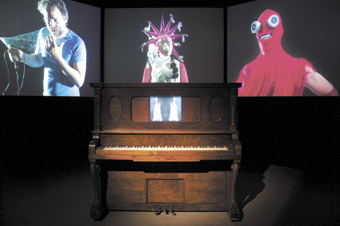Wade Marynowsky’s weblog, Autonomous Mutations, highlights current uncanny art projects and other manifestations of das Unheimliche and is full of fantastic and unique examples of the aesthetic (like Karakuri ningyo), links to Machine art, and also references to uncanny theory.
I say he features the “aesthetic” of the uncanny because his blog is an offshoot of his own excellent art inquiries, featured in “Autonomous Improvisation” one of several multimedia exhibits that Marynowsky has created that integrates popular music with concept art to inquire into the uncanny nature of art and computer programming. Marynowsky describes his initial project (pictured above) and artistic intentions this way:
a prepared pianola is linked to a network of computers and is programmed to orchestrate [a palette of videotaped musicians from diverse genres performing for the camera] creating an ever-changing composition. This is presented via three-channels of audio–visual projection. Through non-determinist re-composition, the work questions if it is possible for improvisation to be programmed, or if this is simply a paradoxical endeavor. More significantly, ‘Autonomous Improvisation v1’ asks us to consider what is imposed on human autonomy in an increasingly computer-controlled society.
The Autonomous Improv exhibit employs stock icons of the uncanny in random patterns (e.g. images flicker on the wall like ghosts, projecting masked singers who look like dolls, mix-mastering clowns working turntables, etc, while the old-fashioned pianola works like a player piano with candles aglow in its heart), but the real effect of the uncanny is felt when all of this “clicks” into an accidental surprise where it seems like the object is actually making music and working in some kind of uncanny harmony.
The following video from YouTube doesn’t do the sound justice, but it is a good example of the exhibit in motion. Those interested in this project should seek out Marynowsky’s DVD from his own Demux label.
In “Alien Jukebox,” a review of the exhibit for ArtSpace, (available in a a pdf file), Sean Lowry raises an interesting question about the role of the artist/author in constructing an experience of the uncanny.
Artists have long created systems or parameters in which events might unfold. Whilst the exact outcome might be unknown, a kind of outcome is expected…whenever an artist has waited for something to rust, for torn paper to fall, for mediums to react with one another, for randomly cut up audiotape to be spliced together, or for an audience to interact with a performance, repeated activities are demonstrated to produce self-similar outcomes rather than specific outcomes. Since Marynowsky has devised the program, he has also designed the kind of outcome that it will produce. But in establishing the parameters within which the work will operate, the fact that its final configuration is automated does not necessarily imply that the technology is acting “on its own accord.”
Here Lowry is arguing against Wade Marynowsky’s assertion that the work is a form of uncanny “automata” because it does not act “on its own accord,” but is rather programmed for a particular outcome to transpire. The so-called “ghost in the machine” was put there by the artist. In other words, the uncanny experience is like a firecracker: it may stun us with a burst of angst in response to its automatic semblance, but the artist has still metaphorically lit the fuse.
But all art has an artist standing in the curtains behind it in some way (even long after his or her death!), and this is not necessarily an issue. It doesn’t reduce the uncanny effect of the artwork on the spectator. Another way of thinking about what I would call the “player piano” effect: the exhibit aims at randomness that syncs up music and image in an uncanny way, but it is nevertheless programmed in much the same ways as a player piano relies upon a script to play its tune. However, in this case, the script roll has been programmed to randomize its notation and express that randomization through imagery of the uncanny that invites the observer to reflect on the random nature of the moment in juxtaposition to its orchestrated planning and programming. It is this irreconcilable conflict, perhaps, which is felt as uncanny.
It is the planned accident that anticipates uncanny synchronicity (a la Karl Jung)…perhaps this is one of the appeals of all improv.
I like how Lowry muses over Marynowsky’s work by recalling and contrasting it to the work of the surrealists, like Duchamp, who employed the uncanny but in a highly conceptual (and less experiential) way. Later in his review, he brilliantly writes that artwork like this is inherently more intimate, a symptom that the role of authorship [has shifted] toward that of artist as facilitator of experience.
Lowry considers the way technology works in relationship to this cultural shift, and muses over its implications:
The viewer now enters a relationship with a machine that extends the art action across time. Just as cinema once provided a new and strange way of experiencing life, the computer is now seemingly and endlessly extending our experience of the uncanny. “Notions of originality,” as French critic Nicolas Bourriaud put it in 2002, “…are slowly blurred in this new cultural landscape”…The challenge facing emerging and hybrid art forms is the need to generate and maintain a public.
Given Marynowsky’s integration of music and programming, and his blog’s features on musical bots, I would imagine that Marynowsky would be interested in David Byrne’s ‘singing robot’ project, and vice-versa.

Hi,
I can say that the feature is great,and a prepared pianola is linked to a network of computers and is programmed to orchestrate was quite interesting.And the technology behind it was nice to play piano for musical lovers.